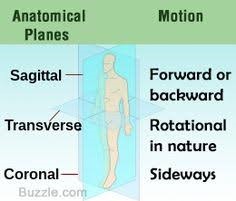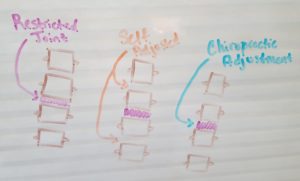In this blog, I’ll try to answer the questions that I often receive as a chiropractor: what am I adjusting and how do I know what to adjust? Our goal is to educate everyone who reads this and to have an understanding of why we adjust. Sometimes people are afraid of being adjusted; but why are they afraid? If you are afraid, most likely it means you are not familiar with something or don’t understand it. Most often once you understand something, it seems less ominous/threatening.
As chiropractors, we go to chiropractic school for about three and a half years, year-round. We graduate with over 250 credit hours and have both a bachelor’s degree and a Doctor of Chiropractic degree. We start day one learning how to assess joints in order to learn and better our skills to adjust. Dr. Tyler and Dr. Michelle also spent endless weekends during school and still take additional courses to hone our adjusting skills. We like to go by the saying, “10,000 hours of perfect practice makes perfect” (from the book, Outliers, author Malcom Gladwell).
In our office, we are movement based. We look at the individual joint and assess whether it is moving and functioning properly. In order to know if something isn’t moving correctly, you have to know normal joint motion. Joints can move in 3 different planes of motion: sagittal, frontal, and transverse. To make sure we are on the same page: sagittal/lateral plane divides the body into left and right; frontal/coronal divides the body into front and back; transverse/horizontal plane divides the body into top and bottom.
 We assess this joint motion through different assessments depending on what joint we are looking at. The joint should feel like it has a little “give” at the end of range of motion. If it doesn’t, we assess whether the joint needs adjusted or if it is a bony block (meaning that there is bone blocking the movement). Our body receives feedback from all nerve receptors in our body and we have nerve receptors in our joints. If our joints are not moving, our brain is not receiving all the feedback it needs which means our brain is almost “blind” to what is exactly going on in that area. If you aren’t receiving the correct feedback this can increase the risk of injury; this would be like taking one of your five senses away and expecting you to be able to function exactly the same with four senses instead of five.
We assess this joint motion through different assessments depending on what joint we are looking at. The joint should feel like it has a little “give” at the end of range of motion. If it doesn’t, we assess whether the joint needs adjusted or if it is a bony block (meaning that there is bone blocking the movement). Our body receives feedback from all nerve receptors in our body and we have nerve receptors in our joints. If our joints are not moving, our brain is not receiving all the feedback it needs which means our brain is almost “blind” to what is exactly going on in that area. If you aren’t receiving the correct feedback this can increase the risk of injury; this would be like taking one of your five senses away and expecting you to be able to function exactly the same with four senses instead of five.
I often hear, “my bone is out of place and needs popped back in”. If your bone was truly “out”, this would mean you have a dislocated joint; this is NOT what we do. If we suspect any dislocation, fracture, etc we will order imaging and/or refer out of our office. We are restoring movement back into the joint with our adjustment.
Knowing where NOT to adjust is just as important as knowing where to adjust. I’ll be honest, growing up I popped my own fingers and neck. I was always told not to do it but never the reasoning behind it and I wish I had been told. Here is the short answer: the general public is not trained in how to adjust and even if you are trained, you cannot adjust yourself. Dr. Tyler and Dr. Michelle adjust each other, we do NOT adjust ourselves; it is not possible. The more detailed answer: the joint that is fixated (not moving) typically will not adjust; you are popping the joint that is already moving or moving too much. Trust me, it feels good for a while, but then the “need” to pop it again comes back. Why? The actual problem was not addressed; the relief you feel is merely our feel-good chemical that our body releases (endorphins) which will wear off.

When Dr. Tyler or Dr. Michelle adjust a patient we aren’t looking for the “pop”. We are looking for joint movement, does it move better after the adjustment? If the answer is yes, then we accomplished what we wanted; if not we will assess what next step needs to be done. The noise is a release of gases (oxygen, nitrogen, and carbon dioxide) that changes the pressure within that joint which helps the joint move better after the adjustment.

Our office looks at what needs adjusted and what doesn’t. As we have said in previous posts, many people need stability not mobility. It often feels as though you need stretching but your body is seeking stability. Contact us to find out what you and your body needs to move better and feel better. Dr. Tyler and Dr. Michelle look forward to seeing you soon!
